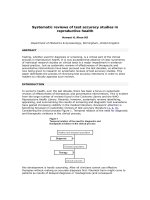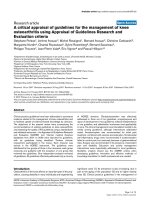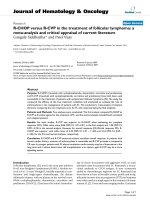Lecture Critical Appraisal of Systematic Reviews
Bạn đang xem bản rút gọn của tài liệu. Xem và tải ngay bản đầy đủ của tài liệu tại đây (183.67 KB, 30 trang )
Critical Appraisal of
Systematic Reviews
Douglas Newberry
Systematic Reviews
—
or How to make a Monkey
out of EBM without hardly
trying!
Systematic Reviews:
Objectives:
• Appraise a systematic review for validity
• Discuss Meta Analysis / use Odds Ratios
• Obtain Number Needed to Treat (NNT)
from Odds Ratios
• Consider clinical implications of a
Systematic Review {including when to
bin it instead!}
We can see further than our
forbearers because we stand on
the shoulders of Giants
{and have better spectacles}
• these ideas are cribbed unashamedly
from friends, books & previous courses
Systematic Reviews:
What are your Objectives:
What do you want to cover?
Please interject with helpful questions!
Did I really want a
systematic review?
(but please do not pretend)
• admit your ignorance — expert review or
consensus guidelines > broad introduction,
cover many areas (class C evidence).
• if the question is important > formulate it!
• Systematic review > narrow but rigorous
focus.
Systematic Reviews — Where
do I start:
• Start with your 4 (or 3) part clinical
question!
• Is a systematic review a sensible
approach?
• Does THIS systematic review address
MY question?
• Is it a systematic review at all?
Is it a systematic review? does it:
• define a four part (answerable) clinical
question?
• combine Randomized Controlled Trials
(RCT’s)?
• describe PRE-DEFINED search methods?
• PRE-DEFINED inclusion criteria?
• PRE-DEFINED methodological exclusion
criteria?
Sceptical View?
Take it with a grain of salt:
• transparent declaration of funding of work?
• Drug Company sponsorship of Reviews vs.
Methodological quality>Cochrane review!
• who employs the authors?
• open discussion of existing controversy &
commercial gain?
• Don’t waste salt on your food, keep it for
your reading!
Meta analysis —
combine what with what?
• Low Molecular Weight Heparin (LMWH)
in hip surgery — begin before or after the
operation?
• meta analysis of placebo controlled
RCT’s of heparin in hip surgery >>
• pre-op & post-op LMWH vs. placebo
• post-op LMWH Vs placebo
• pre-operative >> less intra-op bleeding??
Can we believe it ?
• bias free search & inclusion criteria?
• appraisal of methodology of primary
studies?
• consistent results from all primary
studies?
– if not, are the differences sensibly
explained?
• are the conclusions supported by the data?
If we believe it — does it apply to
our patient?
• Is our patient (or population) so different
from those in the primary studies that the
results may not apply?
• consider differences in:
– time — many things change.
– culture — both treatments and values of
outcomes can be different
– stage of illness or prevalence can effect
We believe it ! but
—>> does it matter?
• Is the benefit worthwhile to our patient?
• Ask the patient about cultural values.
• Think about Relative Risk Reduction vs.
Absolute Risk to our patient.
• Potential benefit is the Absolute risk
avoided in our patient = Absolute Risk
Reduction (ARR)!
Absolute Risk—> The risk our
patient is facing!
• How likely is our patient to die (or have
the outcome of interest) without
intervention? = Control Event Rate (CER)
• consider this individual patient’s risk
factors to estimate Patient Expected Event
Rate = PEER.
• Absolute Risk usually increases with age.
• Improvement measured as Absolute Risk
Reduction (ARR)
Relative Risk Reduction:
• Usually reported in studies.
• Ratio of the improvement of outcome
over outcome without intervention (Rx):
• {Control Event Rate (CER) —
Experimental Event Rate (EER)} / CER
• i.e. {CER-EER}/CER
• often independent of prevalence!
• often similar at different ages!
Our patient wants an absolute
Risk Reduction (ARR):
• is a 40% reduction in Cardiac Risk worth
taking pills daily for 10 years?? >vote!
• if I have a 30% risk of MI or death {30
out of 100 people like me will suffer MI
or death} in next 10 years > 40% RRR >>
only 18 out of 100 will have MI or death.
ARR = 12 out of 100! >>I like that!
• BUT if I have a 1% risk in 10 years, 40%
less is a 0.6% risk >> hardly different!
Number Needed to Treat (NNT)
(very trendy but tricky):
• only defined for specific prevalencePatient’s Expected Event Rate=PEER!
• only defined for a specific intervention!
• only defined for a specific outcome!
– eg. Pravastatin™ 40 mg nocte x10 years,
in a 65 year old male, ex-smoker with
high BP and Diabetes, to reduce MI or
Death.
• NNT is the inverse of Absolute Risk
Number Needed to Treat (NNT)
for previous example:
• 12 fewer MI or death in 10 years per 100
persons treated: ARR=12/100
• NNT = 1/(12/100)=100/12= 8.3
• But the same Relative Risk Reduction
(RRR) of 40% with a low prevalence:
• 0.4 fewer MI/death per 100 treated,
ARR=0.4/100.
• NNT = 1/(0.4/100) = 100/0.4 = 250!
Why Odds Ratios? > compare
results of different studies.
• consider 2x2 table:
• RRR is (a-b/a) — but you can only go in
rows within same study!
• Odds ratio is (a/c)/(b/d) = ad / bc — the
individual ratios are in columns, and
therefore are independent of the prevalence
which is different in different studies.
• must use odds ratios to combine RCT’s
Odds Ratio (OR) to NNT — is the
improvement worth the trouble?
• 1>OR>0, lower the OR = better the
treatment (Rx) >> lower NNT.
• for any OR, NNT is lowest when
PEER=0.5
• estimate the PEER (patient’s risk)
• apply the OR to get patient's NNT.
Convert PEER & OR to NNT:
Control
Event
Rate
(CER)
{apply
PEER
here}
Odds Ratio (OR)
CER
0.9
0.7
0.5
0.1 110
36
21
0.5
38
11
6
0.9
101
27
12
Formula used in the table:
NNT= 1 {PEER * (1OR)}
(1PEER)*(PEER)*(1OR)
Table induced nausea!
• lower OR >> lower NNT
• Patient needs to be at risk (non-trivial
PEER) in order for risk reduction to be
worth the effort.
• for any OR, NNT lowest when PEER=0.5
• more effective treatment > lower NNT
• BUT are your patient’s values satisfied by
the intervention and its sequelae?
Subgroup analysis: Sceptical unless:
• the subgroups make biological and clinical
sense?
• the differences are both clinically &
statistically significant?
• was a-priori hypothesis (before this data)?
• other evidence supports these sub-groups?
• few (OK) or many (nix) sub-group
analyses?
Any Questions?









